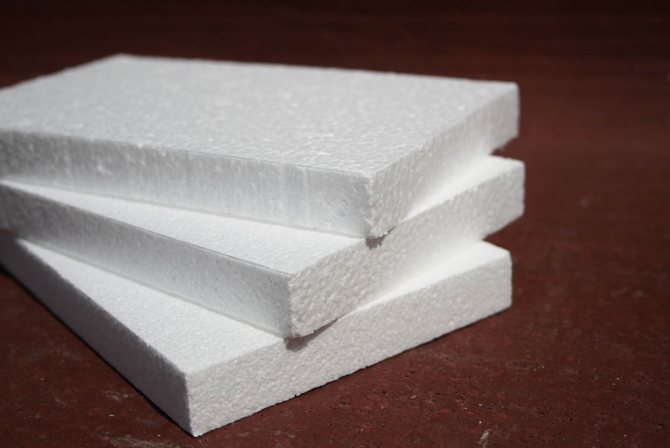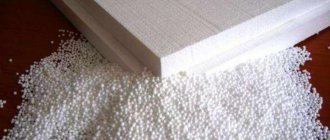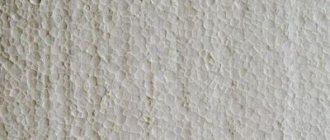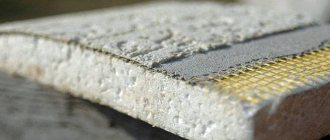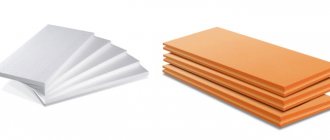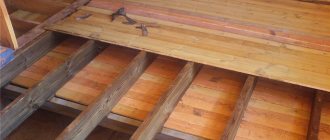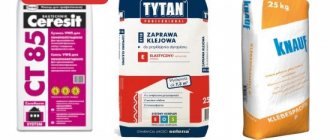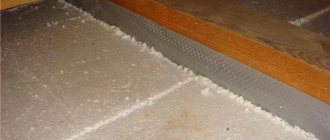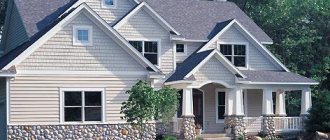In this material: the pros and cons of expanded polystyrene. Simple, detailed and understandable. Perhaps this article will change your plans for home insulation. Read and comment. At the end of the article - reader poll.
Interested in Styrofoam? Have you decided to use it to decorate your home? Then now we will tell you what the advantages and disadvantages of expanded polystyrene.
We will consider mainly using the example of a conventional PSB-S. Let's start with the pros and then move on to the cons of this material. We will tell you absolutely everything, without hiding anything. By the way, according to
Benefits of Styrofoam (Styrofoam)
Low price
Perhaps this is the most important plus of this material as insulation. Now there are many other insulation materials on the market that are superior to foam in a number of properties. However, in many cases, it is the cost of insulation that is of paramount importance. As a result, in many cases, the choice falls on the foam. The amount of money that can be saved thanks to the use of this material is very attractive.
Good thermal insulation
This is also an important advantage of expanded polystyrene. In terms of its thermal insulation performance, it surpasses most other heaters. Due to this, when using foam, you can get by with the smallest insulation thickness. Whereas when using other materials, their thickness (to achieve the same thermal insulation value) can be many times greater.
The following feature is closely related to this.
Light weight
It is a very light material (thanks to its manufacturing technology). And due to this (as well as high thermal insulation properties), for example, when insulating a house, a minimum load is created on the foundation and walls.
This is also an important advantage of foam. It acquires particular importance when insulating multi-storey buildings. There are many floors, but the foundation is one!
Multifunctionality and wide range of applications
This material is used to insulate a wide variety of objects. So, if we talk about houses, then it is used to insulate walls, basements, floors, ceilings.
At the same time, there are several options for insulating certain objects.
This feature makes expanded polystyrene almost universal insulation. An exception is the insulation of the house from the inside - for this, it is better not to use polystyrene.
Durability
The service life is really quite high. This has already been tested in practice. Of course, provided that this material is protected from exposure to sunlight, rodents and other negative factors.
Subject to the appropriate insulation technology, this material can last 30 years or more. Especially if you use high-quality foam, from honest manufacturers.
It is no secret that now on the market there is also low-grade material, which is made without observing all the necessary standards. In this case, of course, there is no need to talk about high durability.
However, if we take into account high-quality expanded polystyrene, then its service life is quite high. According to this indicator, it surpasses some other heaters.
High resistance against fungi, various microorganisms
Another good thing about styrofoam is that it is of artificial origin. This means that it certainly does not attract any microorganisms. That is, they do not start in it and do not multiply, as in the same wood. And, for example, from mold, which will be located in the immediate vicinity, the foam will not collapse.
Another plus for this insulation.
Ease of installation
Any builder who has ever worked with expanded polystyrene will say that it is easy to work with it. This material is easily cut, adjusted to the required shapes and sizes. For example, insulating the walls of a house from the outside with the help of foam is done quickly and easily. What can not be said about some other types of insulation.
However, this is where the advantages of expanded polystyrene end. And now we proceed to consider the cons - the disadvantages of foam. Unfortunately, there are not so few of them.
We emphasize right away: we are not manufacturers of expanded polystyrene. Therefore, we will tell you the whole truth, without hiding anything.
So…
Polyfoam, its characteristics and advantages
This heat-insulating material is produced from polystyrene by foaming and in finished form in it. 98% air, it is a classic type of insulation. Polystyrene granules are treated with dry steam and at the moment of thermal expansion they adhere to each other, resulting in micropores in the finished material. For a long time, people began to use it for thermal insulation at home, use the material to insulate walls, floors, roofs. Such protection not only saves from the cold in winter, but also serves as a kind of protection for the walls of the building.
Due to the basic characteristics of foam, many believe that it is best suited as insulation. Its main qualities can be attribute the following properties.
- It is 98% air.
- Its thermal conductivity ranges from 0.038 to 0.050 W / m K, which is significantly lower than that of wood or brick. For example, wood in terms of thermal conductivity exceeds polystyrene by 3 times, and brick by 17 times.
- Only 2-3cm of foam can make a complete soundproofing of the building.
- They do not absorb moisture more than 3% of its mass and at the same time its thermal insulation properties remain unchanged.
- The light weight makes it easier to work with the material, it is easy to install, no special tools are required for cutting.
- It is non-toxic, odorless, does not generate dust during operation, therefore, protective equipment is not needed during operation.
- Polyfoam is resistant to cement, gypsum, alkalis, water-based paints, but is afraid of acetone and benzene.
- In contact with an open fire, it ignites, but quickly extinguishes.
- The material is environmentally friendly, safe to use and dispose of, it is also widely used in the food industry and as packaging for many goods, including for children.
Styrofoam also has disadvantages, it very fragile material, which in bad weather complicates the work with it, as well as the transportation of insulation.
Despite the fact that foam appeared a long time ago and now there are many new and modern materials, it has not lost its relevance. Its low price is also attractive to many, which makes it possible to use foam in many types of construction work.
Disadvantages of Styrofoam
Gives off toxic substances when burned
We will not delve into chemical processes now. Let's just say that these substances are very toxic and dangerous.
By the way, some manufacturers hide this fact in every possible way. On the Internet, you can even find fairy tales that say:
"Foam plastic, when burning, emits no more harmful substances than ordinary wood ..."
Know: it is not true!
Since ancient times, people have been frying meat, vegetables, and other foods at the stake. At the same time, they sat near the fire, warmed themselves.
And in the case of polystyrene ... this even in a nightmare will not be dreamed of! When burning, very life-threatening substances are released. How can this material be equated with wood in terms of harmfulness?
There are many cases when people were poisoned precisely by gases that were released during the combustion of expanded polystyrene. There are also tragic cases (Google and Yandex will help you).
Therefore, it is strongly We do NOT advise you to use this material indoors.... Consider the high fire hazard.Electrical wiring, household appliances on fire ... Anything can happen. After all, even a small fire of the foam is enough for hazardous substances to be released. Why do you need this?
If you have already decided, for example, to insulate the house with this material, then do it only outside. Do not insulate from the inside under any circumstances!
And even if you insulate the house from the outside, be sure to protect the foam from accidental fire. Take care not only of your health, but also of the health of the people around you.
Does all foam burn the same?
Not. There is ordinary foam, which, on contact with fire, is highly flammable and continues to burn, even on its own.
And there is self-extinguishing polystyrene foam that does not support combustion (a favorite phrase of many foam manufacturers). They say, "does not support combustion, self-extinguishes, so this material is not dangerous."
Yes, self-extinguishing foam will not burn by itself. However, if there are other materials nearby that will support combustion well (for example, wood), then self-extinguishing will do nothing. Such expanded polystyrene under the influence of a third-party fire will continue to burn and still emit harmful, toxic substances.
Moreover, there is an important point! Not every self-extinguishing foam can actually be self-extinguishing... The fact is that now on the market there are many low-grade materials made with large deviations from technological standards.
In other words, the packaging may say that the material is self-extinguishing, but in fact this is not so. Such foam can burn well by itself. Cheating consumers!
Therefore, always ask for a quality certificate when buying, give preference only to reliable, trusted manufacturers.
Release of harmful substances even at low temperatures
It should be borne in mind that over time, expanded polystyrene (especially low-grade) is able to emit into the atmosphere a considerable amount of a harmful substance - styrene. This is especially true in rooms where the air is intensely heated (for example, a kitchen, a bathhouse).
Therefore, remember: no insulation inside the premises! And we do not advise you to glue any decorative polystyrene foam plates to the ceiling. Think about your health and the health of your children!
Creates a vapor barrier
As you know, water vapor accumulates in rooms over time, which tends to go outside (to the street). As they accumulate, the vapors go up and to the sides, trying to get through the walls and ceiling of the building. And, as they say, if “the walls and ceiling are breathing”, then everything will be in order - water vapor will gradually come out without creating dampness in the house.
But if on the way there is material that does not let steam through (or does, but it is bad), then the situation will be different. This will lead to the fact that water vapor cannot escape from the room to the outside normally. Because of this, it will be damp, windows will be covered with condensation, mold, unpleasant odors, etc. may appear. In a word, the indoor climate will worsen.
So ... foam is just such a material that creates a vapor barrier - it prevents the removal of water vapor outside. This will be especially noticeable if, for example, not only the walls, but also the ceiling are insulated with this material.
Yes, some say that supposedly foam plastic (for example, PSB-S) has normal vapor permeability, sufficient to remove steam. However, in practice, as a rule, it turns out differently.
So, if we compare the characteristics of a wall made of red brick with those of such a foam, then the vapor permeability of the second will be noticeably lower - 0.11 versus 0.05 Mg / (m * h * Pa).
Not to mention the extruded polystyrene foam, which creates almost zero vapor permeability.In fact, only reinforced concrete can be insulated with such a material, which also practically does not allow steam to pass through - 0.03 Mg / (m * h * Pa).
Ideally, if the wall consists of several materials, then the vapor permeability in the direction from the inside to the outside should increase, or at least remain the same. And if in some place there is a sharp decrease in the vapor permeability index, this inevitably leads to the accumulation of moisture in the thickness of the wall. Over time, this moisture will negatively affect the indoor climate. Likewise with the ceiling.
Is it possible to somehow deal with this lack of foam?
Yes, you can. To do this, you need to provide a high-quality ventilation system in the house. And this - additional costs, and considerable.
Hygroscopicity
This is the property of the material to absorb moisture. Of course, in terms of hygroscopicity, expanded polystyrene is better than many other heaters. For example, it absorbs much less moisture than mineral wool. Nevertheless, being in water, the foam (normal) will take on some of the moisture.
Therefore, as a rule, it is better to use extruded polystyrene foam for insulation and warming of damp rooms.
Afraid of the sun's rays
This material is destroyed by ultraviolet radiation. And pretty quickly.
This must be taken into account, both during storage and during its direct use. For example, after facing the walls of a house, you need to cover the insulation with a protective layer of glue and plaster as soon as possible. The sun's rays should not be allowed to fall on the foam for months. Otherwise, its surface will be strongly destroyed (it will begin to turn yellow and crumble).
Whole until the mice got there
Mice gnaw on styrofoam, and very actively (we wrote about this earlier). If the rodents get to him - "write wasted." There will be a hole in the hole. Mice make holes in this material, equip nests for breeding. Apparently, rodents like that it is warm and easy to chew on.
Not resistant to solvents
This also needs to be taken into account. When any solvents hit the surface of expanded polystyrene, it begins to disintegrate almost instantly. It seems to dissolve, melts from their action.
Therefore, if it is necessary to paint this material, the choice of paint must be taken seriously. You can only use such paints and varnishes that do not contain solvents. No white spirits or solvents!
Low resistance against mechanical damage
This is not to say that this is a big drawback of foam. However, it is there. Do not say, but this material has low strength, easily destroyed by mechanical stress. This manifests itself not only during installation, but also, for example, during transportation. It is not uncommon to see sheets with uneven edges (chips are present).
Of course, this parameter directly depends on the density of the foam. The higher it is, the greater the strength. Nevertheless, whatever one may say, the material needs additional protection.
Why prepare Styrofoam?
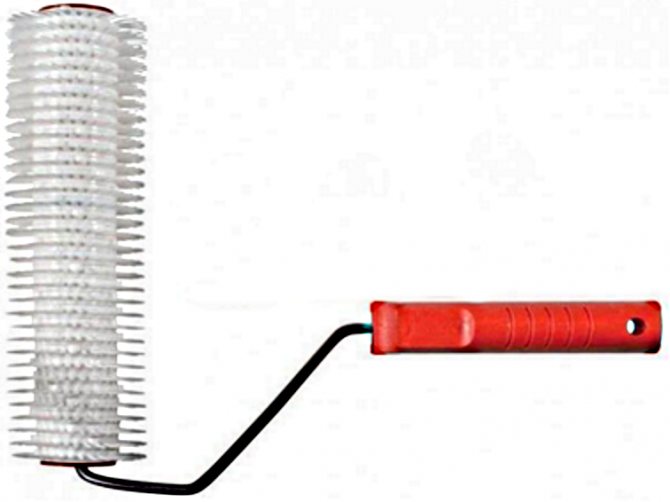
Plates of expanded polystyrene, especially extruded, have a smooth surface, which makes it difficult for them to adhere to the adhesive solution. Therefore, before insulation, they need to be made rough.
To do this, you can use the tools at hand - sandpaper or a knife. Craftsmen often use a needle roller. This significantly speeds up the process of preparing the insulation.
Advice... In the same way, it will be necessary to process the surface of the foam after the walls are insulated before plastering.
Foam installation technology
As soon as the base and insulation are prepared, set the zero level. If all the corners in the room are straight, it can be omitted, taking the floor surface as a reference point. The adhesive composition is sealed with water in the correct proportion and thoroughly mixed.
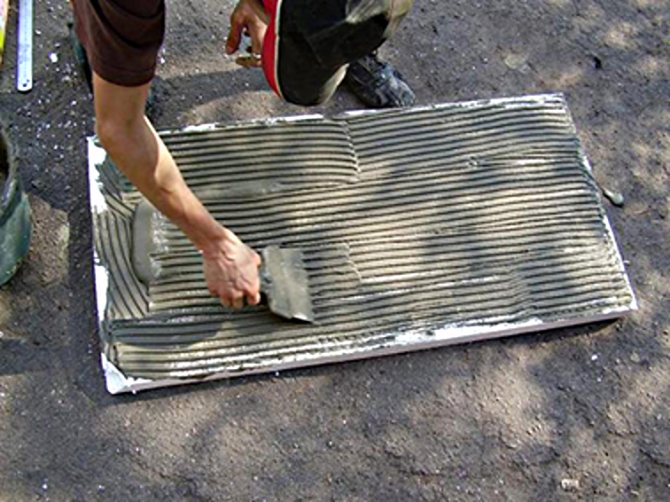

Glue is applied to the foam sheet in an even thin layer, paying special attention to the edges and corners. The insulation is installed in the lower left / right corner and pressed against the wall. Do the same with the rest of the sheets. All edges of each plate are lubricated with a sealant. The installation is made as tightly as possible.
The second row of insulation is shifted relative to the first by half of the slab. They do the same with the third and subsequent ones. For plastering the foam, its additional fastening is required. Use plastic disc plugs. They must be placed at the junction of three plates and always in the center of each insulation plate.
Installation of false walls and finishing
Wall insulation with polystyrene foam in a residential area requires finishing. At a distance of about three centimeters from the insulated surface, a false wall made of plasterboard can be installed on the frame with its subsequent finishing with wallpaper, or a wooden lining, which must be treated with antiseptics. Styrofoam can also be plastered, and bark beetle can be applied on top - a kind of decorative plaster.
Pros and cons of polystyrene: draw conclusions
As you can see, there are more disadvantages than advantages. However, we promised you that we would tell the whole truth without hiding anything. We have fulfilled our promise.
And to use this material for your purposes or not is up to you, of course. Anyway, now you know about all the pros and cons of Styrofoam. This means that you will make the right choice.
The general conclusion can be made as follows.
Yes, expanded polystyrene has high thermal insulation characteristics, an attractive price and other advantages. However, one must also take into account the risks and threats to health that this material is capable of carrying. And the expediency of using foam must be considered in each case separately.
And now the poll. Tell us what you think of this material.
Interview
Should you use polystyrene as insulation for your home?
Also write your opinion in the comments.
Make the right choice. Equip yourself wisely!
Vyborstm.ru


